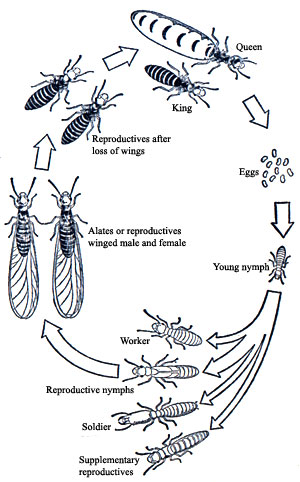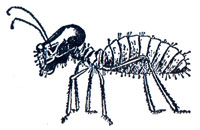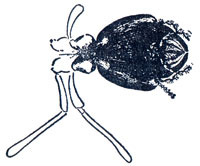11. Uninherited Instincts
I HAVE said that in the termite queen, pain accompanied the laying of the first eggs. It is usually very difficult to be certain of the perception of pain in the animal world, for the outward signs vary enormously in different races and in varying circumstances. In general, however, one may say that the outward signs of pain are more or less similar in all higher animals. If an animal is wrung by convulsive spasms, makes needless movements of its limbs, draws back the head, and at the same time moans and groans, one recognizes that it is in pain, although one may not know the cause of the pain. This expression of pain is an international language amongst animals, and even man knows it from childhood. Most insects speak the same language, without, however, the audible sounds. Therefore anyone, watching the bodily movements of the queen termite which I have described, will feel certain they are the expression of pain. If one is in any doubt, one can dispel this by actually hurting the queen and comparing her behaviour with that which occurs when she is laying her first eggs. Touch certain parts of her body with a glass rod dipped in sulphuric acid and immediately we see the identical waving of the antennae, the writhing of the body, and so on, exactly what happens when she is laying her eggs.
The greatest proof to me, however, was found in her behaviour after her eggs were laid. It is not scientific proof of course. I am trying to establish the connection between the cause and effect, and now I am taking the effect as proof of the cause. Yet everyone will grant that a general knowledge of animal behaviour can find proof in itself. When I say that as soon as I observed the bodily movements of the queen, I immediately realized that she was in pain, and that I then could prophesy that as result of this she would in all probability show signs of affection for her young. Although both occurrences were so improbable, it only indicated that I possessed some special fragment of knowledge which could, if necessary, produce proof. Long before I made acquaintance with the queen in travail, I had come to the conclusion that birth pain was the key to mother love. Let us watch her behaviour immediately afterwards.
On the little garden patch where the first eggs are laid, we see the king and queen continually wandering around. They are busy irrigating and fertilizing the fungi-beds. Soon the first larvae appear. We see them wriggling in the garden, small, white, helpless babies, but we can already distinguish the different kinds, the so-called soldiers and the mandibulated workers. The queen appears among them. We see something glisten in her jaws. In the stream of light it looks transparent and pure as a diamond. Under the magnifying glass we see it is a drop of fluid. She approaches one baby after another, they lift their heads and you see the drop disappear. The queen is busy feeding her little ones.
As I said before, behaviour such as this is unknown in insects at the same stage of development. The nearest approach to similarity is the statement of von Buttel-Reepen that a certain bee, Halictus, lays her eggs so slowly that the first eggs hatch before she has laid the last, and that she therefore comes in touch with her own living young. I think that in that case it is sheer chance; but even that instance is so exceptional that stress must be laid on it. Of care and feeding, however, there is no mention.
With this feeding and preparation of the first soldiers and workers, the individual labour of the king and queen comes to an end, and so does our own opportunity for observation. From now on the community suffers from photophobia -- fear of light -- to such an extent that the usual methods of observation are impossible. This draws our attention to a phenomenon which is as mysterious as the transference of the queen from cell to cell. The king and queen do not possess this instinctive photophobia. They are ordinary winged insects, and only a short while before we saw them in the sunlight flying around, The soldiers and workers, on the contrary, are totally blind and hate the light. How can they possibly inherit a hereditary instinct which the parents do not possess? Nor is this all. The soldiers and workers inherit many instincts which the parents do not possess. They begin immediately building complicated structures. They make cells, passages, aqueducts and a crust containing various forms of arch. One can separate a part of the termitary with a steel plate, in such a fashion that there is no communication between the termites on each side of it. Nevertheless the same curve of arch, or a lower one, as the case may be, is built on either side of the plate. They become aware of the presence or absence of light on the surface through twelve inches of opaque earth. They manufacture cardboard from grass-stalks and wood. They steal eggs from other termites and carry them to the breeding chambers and care for them. They take care of the larvae and feed them, but this is of course an instinct which the queen possesses. They make gardens and replant dried-up gardens. From whom do they inherit these hereditary instincts? All soldiers and workers have the same instincts. Throughout nature we find hereditary instincts of the kind inherited by an organism only from parents with similar instincts. Whence come the special instincts of the sexless forms in the community? The king and queen cannot hand them on, because they themselves do not possess them, nor do they take part in or come in touch with the communal life of their citizens; the soldiers and workers cannot hand on their instincts to other soldiers and workers, for they take no part in the reproduction of the race.

The life cycle of termites
|
I must admit that all this has never seemed a mystery to me, for I felt I had long ago discovered the secret. When one knows the answer to a problem, it can never appear impossible to solve.
In some ways this is the most mysterious occurrence in the life-history of the termite. It deserves careful attention. It is a strange and interesting fact that inexperienced observers seldom become aware of these mysteries, still less do they seek an explanation.
In connection with this riddle, I want to show how modem European learning handles cases of this kind, and the explanation it finds. I am able to do this through the kindness of a correspondent, personally unknown to me, who sent me a monograph written by Professor Dr Bugnion of the University of Lausanne. Dr Bugnion has studied termites in Ceylon for some years, and this monograph is to form part of a monumental work of the famous psychologist Auguste Forel. The title is 'The Community World of the Termite'. Dr Bugnion discusses in particular the wars between the ants and the termites, with special reference to the origin of instinct. As would be the case in any tropical country, Dr Bugnion saw many instances of attacks on termites by ants. He ascribes all the instincts and variations in form of the termites to this continuous state of warfare. I must state at once that I had practically no evidence of this ant warfare in Waterberg. On the contrary, we know that one of the nimblest and most ferocious of our flesh-eating ants lives by choice in a termitary belonging to one of the most helpless of termites which possesses no soldier class. If we break open such a termitary, it is easy to get an impression of war, which nevertheless is based on inaccurate observation. There is no war; in fact most probably it is protection and. friendship. This may be proved by anyone who cares to do so. If we break down a number of the smaller termitaries, sooner or later we come upon one which ants and termites occupy together. Of this small, pale termite there is only one class, the worker. Look at them under a magnifying glass. Their manner of building is entirely different from that of the termite we have studied hitherto. The workers appear immediately at the edge of the wound. But they do not carry stones and stick these together to mend the breach. These pale termites build with clay only. Each worker who appears at the margin of the wound tests a place with his jaws, swings round with a characteristic movement and deposits a small layer of clean soft mud. Sometimes he deposits just a spot, more frequently a little layer. Dr Bugnion had the opportunity of seeing the collection of this mud, but he could not actually see what the termites were doing. What I have told will enable everyone to recognize this particular termite. Among the termitaries broken into, we are sure to find one where a section is inhabited by a dark grey ant, nimble, ferocious and excited. At first sight it appears very much as though these ants are bent on slaughter. They run rapidly between and over the termites, apparently inspired with terror and fury. Occasionally one of them will seize a termite and carry him a short distance. Sometimes a termite will grip the leg of an ant and be dragged about without apparently causing the ant any inconvenience. The wounded termites also are seized and dragged about. In the meantime the other termites quite peacefully go about their business of repairing their fortifications. The ants continually touch and test the repairs, but they never attempt to throng into the passages or to hinder the workers in any way. They appear to have special entrances to the innermost parts of the nest. The observer speedily comes to the conclusion that there is here nothing comparable to murder or war. What it actually was I had no opportunity of discovering. Much time is necessary to study even a single phenomenon of termite behaviour in a dry country like South Africa. I believe this communal life of termite and ant, whatever its basis may be, holds many surprises in store for scientists. We find, however, in South Africa little evidence of the tropical strife of which Dr Bugnion speaks, and realize that it is extremely easy to come to unsound conclusions.

(Eutermes or Trinervitermes.) Mandibulated worker; water carrier, mason, probably also gardener, nurse and feeder. One of its most important functions is to bring all coarse foodstuff into the general metabolism. These workers form part of what corresponds to the blood-stream in higher animals. Colour: Somewhat etiolated with light red markings. Blind, no organs of hearing, sexless.
|
In a later, chapter I will try to interpret these first labours of the king and queen. At present it is sufficient to say that with the attainment of adult stature by the workers and soldiers, systematic observation becomes impossible. The first and most important reason for this is the photophobia already mentioned. All the first efforts of the workers and soldiers are concentrated on sealing up all holes by which light can enter or the observer can watch them. If one perseveres and reopens these holes, the termites simply vanish and that is the end of the nest which took so much time and patience to bring into being. It is possible, however, by breaking into many termitaries to form a fairly accurate picture in our minds of the further course of events in the community. A cement chamber is made for the queen and she is imprisoned there. Passages are made in all directions for the conveyance of coarse food to the different digestive centres; gardens are cultivated on a large scale and planted with fungi; construction of the superficial defensive crust forms an important part of their work.
To come back to this great mystery of inherited instinct, every organism, excepting the apes and man, inherits from its parents all the instincts, that is hereditary environmental memory, which it needs for its own struggle for existence. It is born with the knowledge of what kind of food it needs, where and how to obtain it; it knows its natural enemies and how to defend itself against them; it knows how to make a nest or other home; how to feed its little ones and to care for them. All this knowledge is there without the organism having to learn it, without even coming into touch with the other individuals of its race. I gave an interesting example of this in the South African yellow weaver bird, which, after being kept out of its natural environment for four generations, by hatching the eggs under canaries, instinctively knew how to build its characteristic nest and how to feed its young.

Head of Eutermes worker from below, showing the mouth -parts. These are specially developed for purposes of building and feeding.
|
No one taught these birds. Four generations of their ancestors had never seen a plaited nest or tasted a worm, yet the fifth generation remembered what to do. This is what is called instinct or hereditary environmental memory. In the termite we find three apparently different insects -- the queens, the workers and the soldiers, being produced from one father and mother who are completely different from two of their offspring. If one did not actually know the contrary one would believe the inmates of the termitary to be completely different insects.
With the physical difference go special hereditary memories or instincts. The soldier is armed with the first hypodermic syringe made by nature, which she eventually perfected in the poison fangs of the adder. In his polished head the termite soldier carries a little flask of poison.and on his forehead a needle-like tube through which the sticky fluid is squirted. He uses his weapon only against threatening enemies or strangers. The worker has strong, well-made jaws and a glue-producing gland which he uses to construct most complicated building operations. As soon as he has reached adult stature he begins to make gardens, care for and feed the king and queen, tend the hatching eggs, carry food and partially digest it for the benefit of the whole republic. Both these insects are totally blind, neither of them possesses eyes or other organs of sense; nevertheless they are aware of the presence or absence of light through twenty-four inches of compact earth.
Next: 12. The Mysterious Power which Governs
Table of Contents
Back to the Small Farms Library

